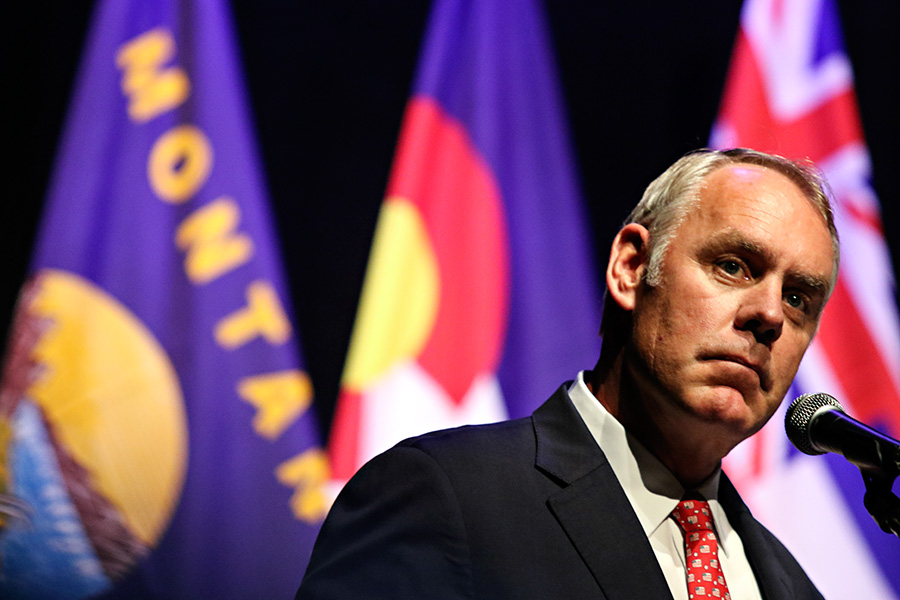The Voice of Rural America
Interior Secretary Ryan Zinke, a Whitefish native, understands Montana. But critics wonder whether the Treasure State has a balanced voice in Washington, D.C.
By Tristan Scott
Speaking before a cadre of Western governors in his hometown of Whitefish, Interior Secretary Ryan Zinke described his approach to overseeing the nation’s sprawling tracts of public land in terms of centuries, a visionary planning strategy he likened to Teddy Roosevelt’s “passion for protection into perpetuity.”
His plan to build revenue and make up for a staggering shortfall stemming from the National Park Service’s maintenance backlog includes privatizing campgrounds and removing roadblocks that hinder development, while restoring trust between government agencies and the nation’s Western citizens stands as a top priority.
“It’s time to look at what the Department of the Interior should be 100 years from now,” Zinke said June 27 during the three-day annual Western Governors’ Association meeting at the Whitefish Performing Arts Center, speaking on a stage where Zinke said he played trombone in band as a young student.
But critics wonder if Zinke has strayed from his roots at the doorstep of Glacier National Park.
Drawing applause from audience members for his pledge to remove bureaucratic obstacles hindering lucrative development and to end the process of compensatory mitigation — where fees are charged to private development companies to offset the harm dealt to public land — he also earned rebukes from environmental groups who worry his priorities are skewed toward extraction on public lands rather than preservation.
Chris Saeger, executive director of the Whitefish-based Western Values Project, an energy-development watchdog group, said he was hopeful that a Montanan at the helm of the Interior would augment the Treasure State’s voice and prop up platforms that balance development and conservation.
Instead, Saeger said it appears Zinke’s allegiance lies squarely with the energy sector.
“You wouldn’t have learned it from this speech, but Secretary Zinke has blindsided Western governors with ill-advised reviews of plans that balance development and conservation,” Saeger said. “He’s proposed making it more expensive to access public lands, while opening the door for D.C. lobbyists to profit from our national heritage. Nothing about the way he’s leading our nation’s largest public lands management agency could make Westerners or our leaders proud.”
The Interior Department is responsible for managing one-fifth of the nation’s territory and employs 70,000 people. Zinke said his aim is to carry out a “reorganization” effort and seek ways for a multitude of agencies to work jointly and more efficiently.
During the conference, where the audience included energy executives, technology entrepreneurs, political consultants, and government affairs liaisons, Zinke emphasized that the U.S. has abundant offshore oil and gas reserves, but the federal government has placed 94 percent of these areas off limits to exploration and production.
By opening up some public lands and maximizing energy-production revenues, Zinke said royalties could more than make up for the National Park Service’s maintenance backlog and boost agency coffers.
“As Interior Secretary, I’m looking at both sides of the balance sheet,” he said. “There’s a consequence when you put 94 percent of our offshore off limits.
There’s a consequence of not harvesting trees. There’s a consequence of not using some of our public land for the creation of wealth and jobs.”
Meanwhile, down the street in Depot Park, several outdoors groups hosted a rally designed to coincide with Zinke’s speech to the Western governors, which organizers said they hoped would encourage the Interior Secretary to protect public lands and national monuments.
One of Zinke’s most controversial moves has been to embark on a review of 26 national monuments across the country, including the Missouri River Breaks National Monument in north-central Montana, which he told reporters he intends to “leave as is.”
“I would rather not open up a wound that has been healed,” he said of the monument.
Still, critics pointed to a host of other controversial moves they say give short shrift to public lands.
Bonnie Rice, of the Sierra Club’s Greater Yellowstone/Northern Rockies campaign, spoke out against the Interior Department’s review of monuments, as well as its recent actions to approve the Keystone XL Pipeline, remove Yellowstone-area grizzly bears from the Endangered Species List and open up the Arctic National Wildlife Refuge to energy exploration.
“Ryan Zinke likes to style himself as a modern-day Theodore Roosevelt. He’s a long way from that,” Rice said. “Any attempt to revoke or change the fabric of our national monuments is an assault on our nation’s historical, cultural and natural heritage.”
One day earlier at a similar rally, Whitefish Mayor John Muhlfeld held up the community’s suite of successful conservation projects as an example of how protecting public lands is a boon to local communities and their economies.
“These projects have secured the public’s access to recreation, protected our viewshed and municipal water supply, while at the same time allowing for sustainable forest management that keeps Montanans working in our forests and in our mills,” Muhlfeld said. “As a friend of Ryan Zinke, I urge him to respect and protect America’s public lands in Montana and across the country. Montana’s economic future depends on it.”